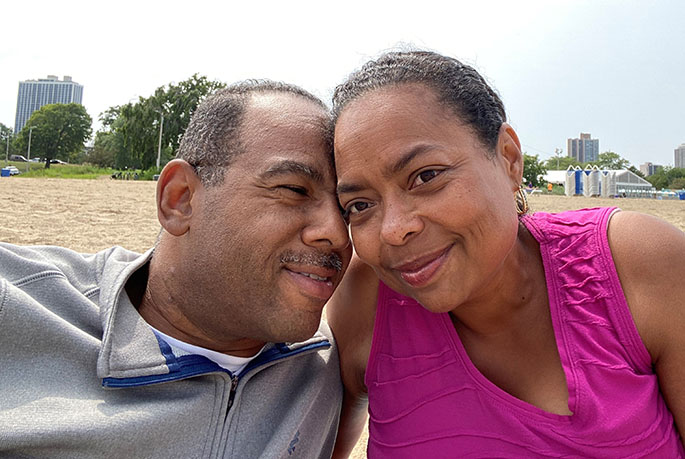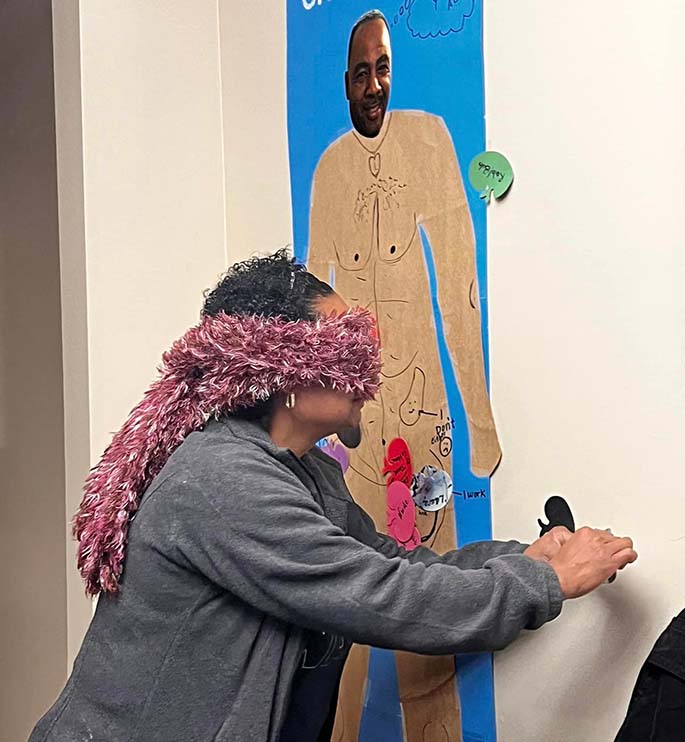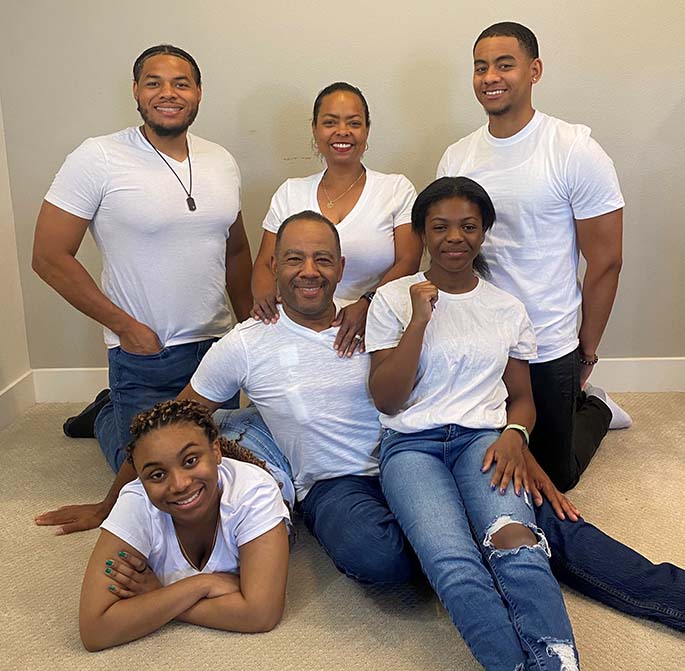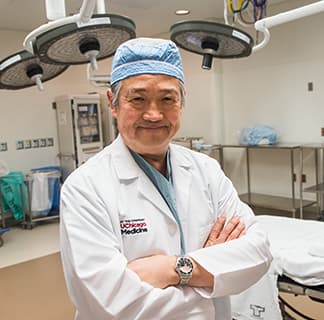‘Too many more years to live’: Tinley Park woman becomes living donor for husband needing kidney transplant

LaVerne Bartee, 51, had never donated blood before. But in October 2022, the University of Chicago Medicine Comer Children’s Hospital events and communications manager was working near a hospital blood drive and decided to donate on a whim. A few weeks later, she discovered she had the same blood type as her husband with kidney failure who was on the waiting list to receive a kidney transplant.
“There was no doubt in my mind what I was going to do,” LaVerne said. “I had no hesitation. I was in complete peace about it.”
She quietly began testing to see if she would qualify to be a living donor for her husband, Kevin Bartee, 53. The Tinley Park couple had been together more than 30 years and had four children, one of whom was also in the process of being tested as a potential organ donor. But LaVerne wanted to be the kidney donor rather than have her son do it. When it started looking like LaVerne would qualify, she finally told Kevin, “I’m going to give you a kidney.”
Are you eligible to be a living kidney donor? Learn more.
More than 5,800 living donor kidney transplants took place in the U.S. in 2022, but there are approximately 90,000 people on the kidney transplant waiting list. Kidneys from living donors are healthier than kidneys from deceased donors, function longer and can allow some patients to get a kidney transplant before starting dialysis, which is better for long-term health.
“Living donors do something else very special that they might not even realize. They decrease the number of people depending on a deceased donor, which allows a kidney to go to someone else,” said UChicago Medicine nephrologist Michelle A. Josephson, MD. “They’re critical. They’re absolutely heroes.”
Living donors decrease the number of people depending on a deceased donor, which allows a kidney to go to someone else.
“I felt like I was a healthy person”
Kidney failure took Kevin by surprise. He’d been monitoring elevated kidney numbers for a couple of years, but a few weeks after a mild COVID-19 infection in January 2022, he wasn’t eating or sleeping well and was losing weight quickly.
Hours after an appointment with a primary care provider, he got a phone call that he had kidney failure and needed to get to an emergency room immediately.
Kevin had surgery so he could receive emergency dialysis. A month later, he was told he would need a new kidney.
“It really was a life-changing process,” Kevin said. “I felt like I was a healthy person. I had some issues with blood pressure but was taking medicine. To go from being able to work every day to suddenly doing four hours of hemodialysis three days a week, it was very emotional and draining.”

By July, Kevin had switched to peritoneal dialysis — a type of dialysis that uses the lining of the belly to filter blood inside the body and could be done from home. He had more flexibility in his day-to-day life but eventually needed 10 hours of peritoneal dialysis a night.
Patients can spend three to five years waiting for a kidney transplant from a deceased donor, but finding a living donor can mean a new kidney within months. It’s why LaVerne was so clear-minded about her decision.
“We had too many more years to live,” she said. “I thought if Kevin could get back to feeling normal again, we could finish out everything we wanted to do.”
Quick work and better outcomes
On Jan. 31, 2023, Kevin and LaVerne underwent their coordinated surgeries at the University of Chicago Medical Center in Hyde Park.
LaVerne was up first with her surgeon Piotr Witkowski, MD, Director of the UChicago Medicine Pancreatic and Islet Transplant Program. About halfway through LaVerne’s three-hour surgery, Kevin’s began. His two-and-a-half-hour case was performed by Rolf Barth, MD, Director of Liver, Kidney and Pancreas Transplantation.
UChicago Medicine living donor kidney transplant program has a 100% one-year success rate for recipients.
In total, LaVerne’s kidney was only out of a human body for an hour, which included the time it took to flush the kidney, cool it, put it on ice and sew it to Kevin’s blood vessels.
“That’s pretty quick,” Barth said. “Most of us can’t transfer flights in an hour.”
Kevin’s new kidney began working and producing urine right away — another benefit of receiving a kidney from a living donor.

“When we take kidneys from deceased donors, it might take a week or two before the kidney begins making urine,” Witkowski said. This can be due to how the deceased donor died and the time the kidney spent outside of a human body, which can be up to 48 hours.
Read our tips for finding a living donor
“The Bartees are a great example of everything going well,” Barth said. “We would pick this path for every patient if we could.”
Gratitude for living donors
LaVerne was able to go home after two days, which is typical for living kidney donors. Kevin went home after six days and has had a slightly longer recovery. Both are now doing well and are back at their Saturday date nights with their bowling league.
The pair are grateful to the whole transplant team at UChicago Medicine — the surgeons, the nurses, the coordinators and other staff. Kevin receives follow-up care with Josephson and her nephrology colleagues through a team-based care model. He’s amazed at his fortune and how good he feels.
“I feel very blessed that I have a new kidney after only a year,” he said.
“Living donor kidney donation offers people a bright light at the front — and not the end — of the tunnel,” Barth said. “The donors are amazing people. One of the most special things we do in transplant is care for our living donors. It’s a meticulous and careful process. Even with the motivation of a family member to donate at whatever cost, our goal is still to prioritize the safety of the donor and not take unnecessary chances.”
Barth noted that the UChicago Medicine living donor kidney transplant program has a 100% one-year success rate for recipients.
“This shows the care we take with these very special gifts,” Barth said. “A donor can feel that their kidney is entrusted to a program with the highest success rates and most predictable outcomes to treat kidney failure.”
As a donor, LaVerne will need to maintain a healthy lifestyle to keep her remaining kidney healthy and help prevent high blood pressure or diabetes. But she’s otherwise not limited in any way.

“The only thing living donation prevents someone from doing is donating their second kidney while they’re still alive,” Barth said.
With this latest hurdle behind them, Kevin is most looking forward to spending time with family and trying to repay LaVerne for giving him a kidney.
“After 30 years, do you know how much I have to hold over him?” LaVerne said with a laugh. “This is just one little nugget.”

World-Renowned Transplant Specialists
The University of Chicago Medicine is home to hundreds of medical experts.
Find a transplant specialist